The Role of Technical Innovation and Sustainability on Energy Consumption: A Case Study on the Taiwanese Automobile Industry
Abstract
:1. Introduction
2. Literature Review
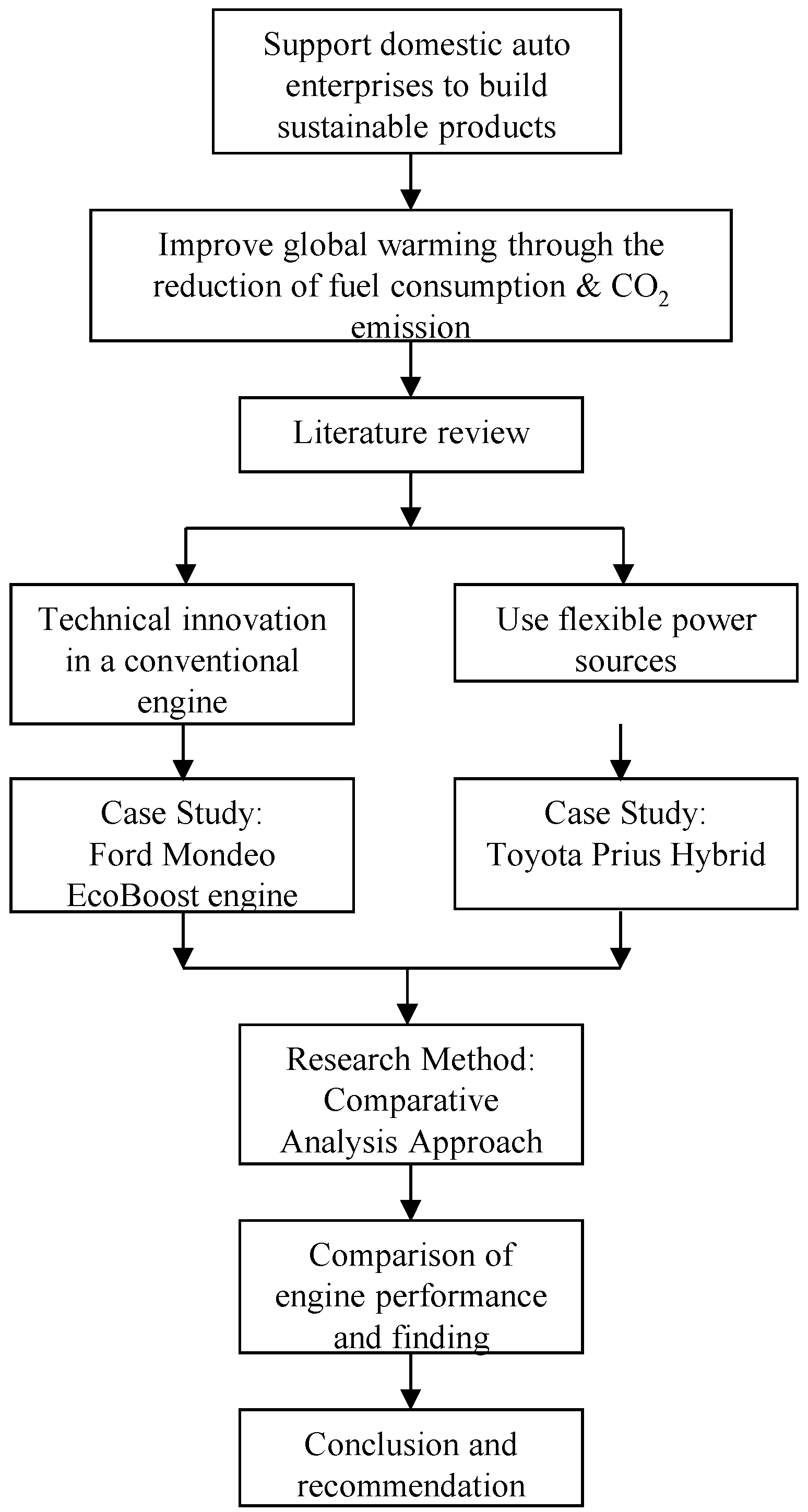
2.1. What Is Global Warming?
2.2. Causes of Global Warming
2.3. What Are Greenhouse Gases?
2.4. Technical Innovations
2.4.1. Turbocharger
2.4.2. Hybrid Vehicles
2.5. Sustainable Development
3. Research Method
4. Voluntary Carbon Dioxide Reduction Agreement (Taiwanese Environmental Protection Administration)
5. Comparison of Engine Performance in the Taiwanese Automobile Market
5.1. Ford EcoBoost Engine

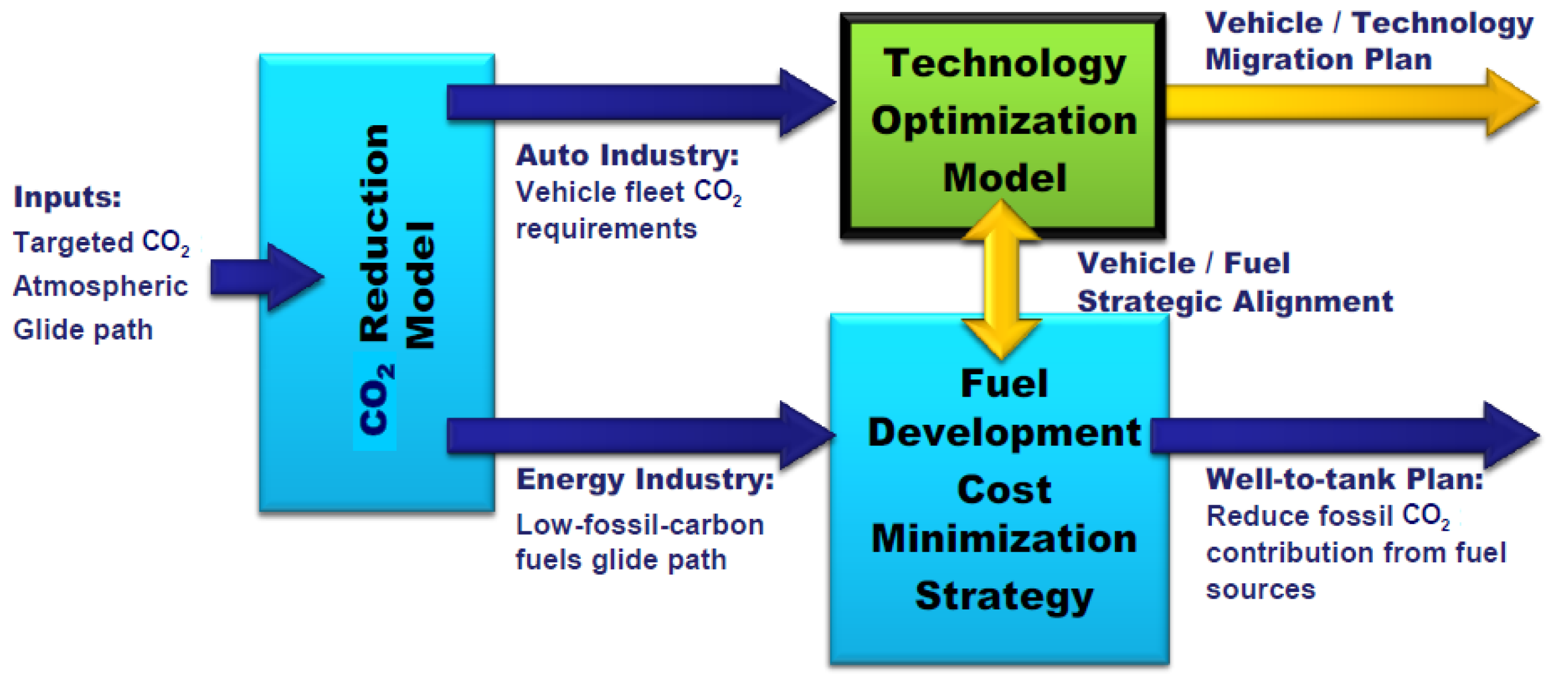

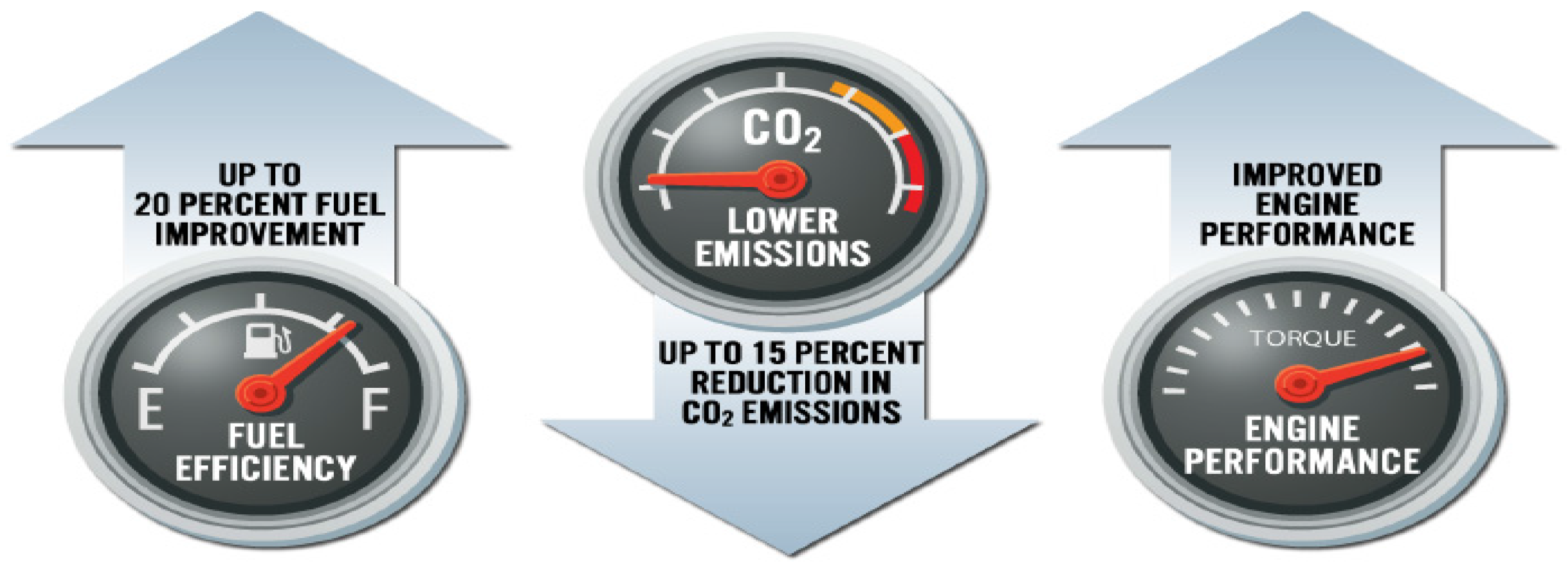
| Brand | Model | Displacement (cc) | Maximum HP/RPM (hp/rpm) | Maximum Torque/RPM (kg.m/rpm) | HP/displacement(hp/cc) | Torque/displacement (kg.m/cc) | Data source | ||
|---|---|---|---|---|---|---|---|---|---|
| Ford | Mondeo EcoBoost | 1999 | 240 | 6000 | 34.7 | 3500 | 0.12 | 0.017 | [34] |
| Kuga EcoBoost | 1998 | 242 | 5500 | 35.7 | 3000 | 0.12 | 0.018 | ||
| Toyota | Camry | 1998 | 148 | 6000 | 19.4 | 4100 | 0.07 | 0.010 | [35] |
| Camry | 2494 | 181 | 6000 | 23.6 | 4100 | 0.07 | 0.009 | ||
| Nissan | Teana | 1997 | 134 | 5600 | 19.4 | 4400 | 0.07 | 0.010 | [36] |
| Teana | 2496 | 180 | 6000 | 23.2 | 4500 | 0.07 | 0.009 | ||
| Mitsubishi | Outlander | 2359 | 172 | 6000 | 24.0 | 3900 | 0.07 | 0.010 | [37] |
| Zinger | 2378 | 159 | 6200 | 22.6 | 4300 | 0.07 | 0.010 | ||
| Honda | Accord | 2356 | 180 | 6400 | 25.0 | 3500 | 0.08 | 0.011 | [38] |
| CRV | 1997 | 155 | 6500 | 19.4 | 3500 | 0.08 | 0.010 | ||
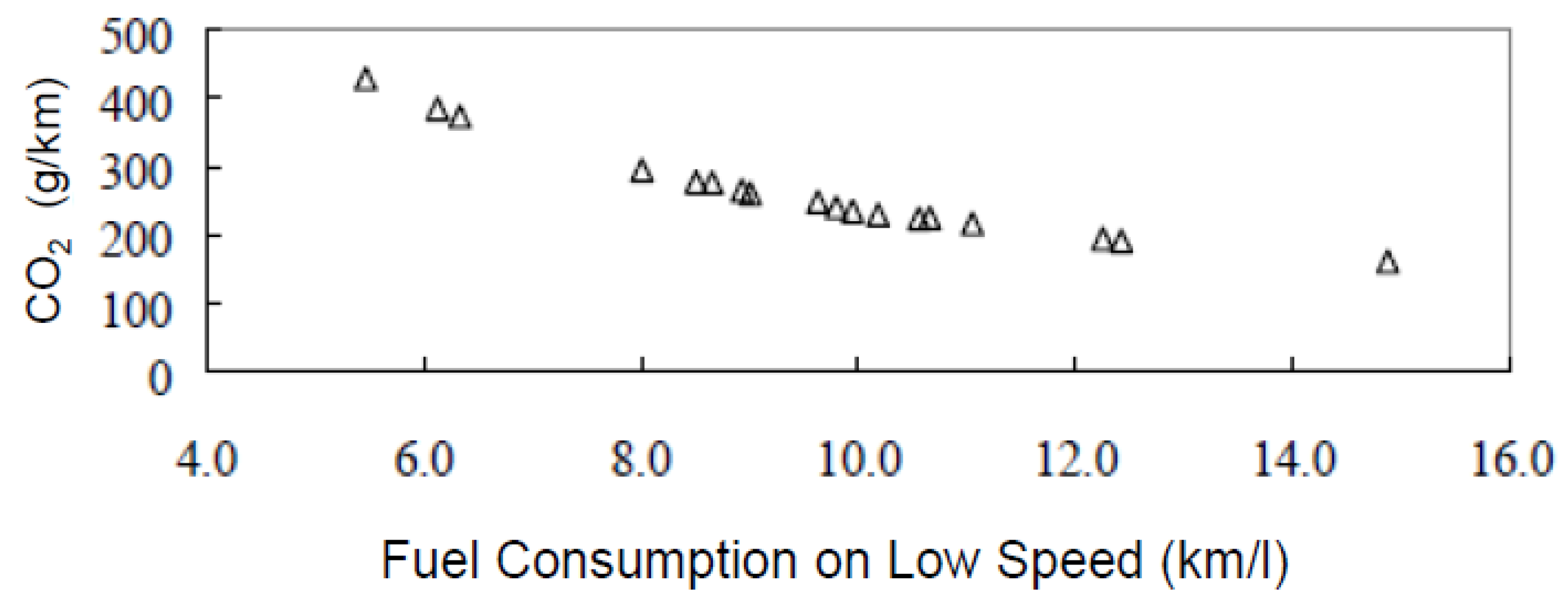

5.2. Toyota Hybrid

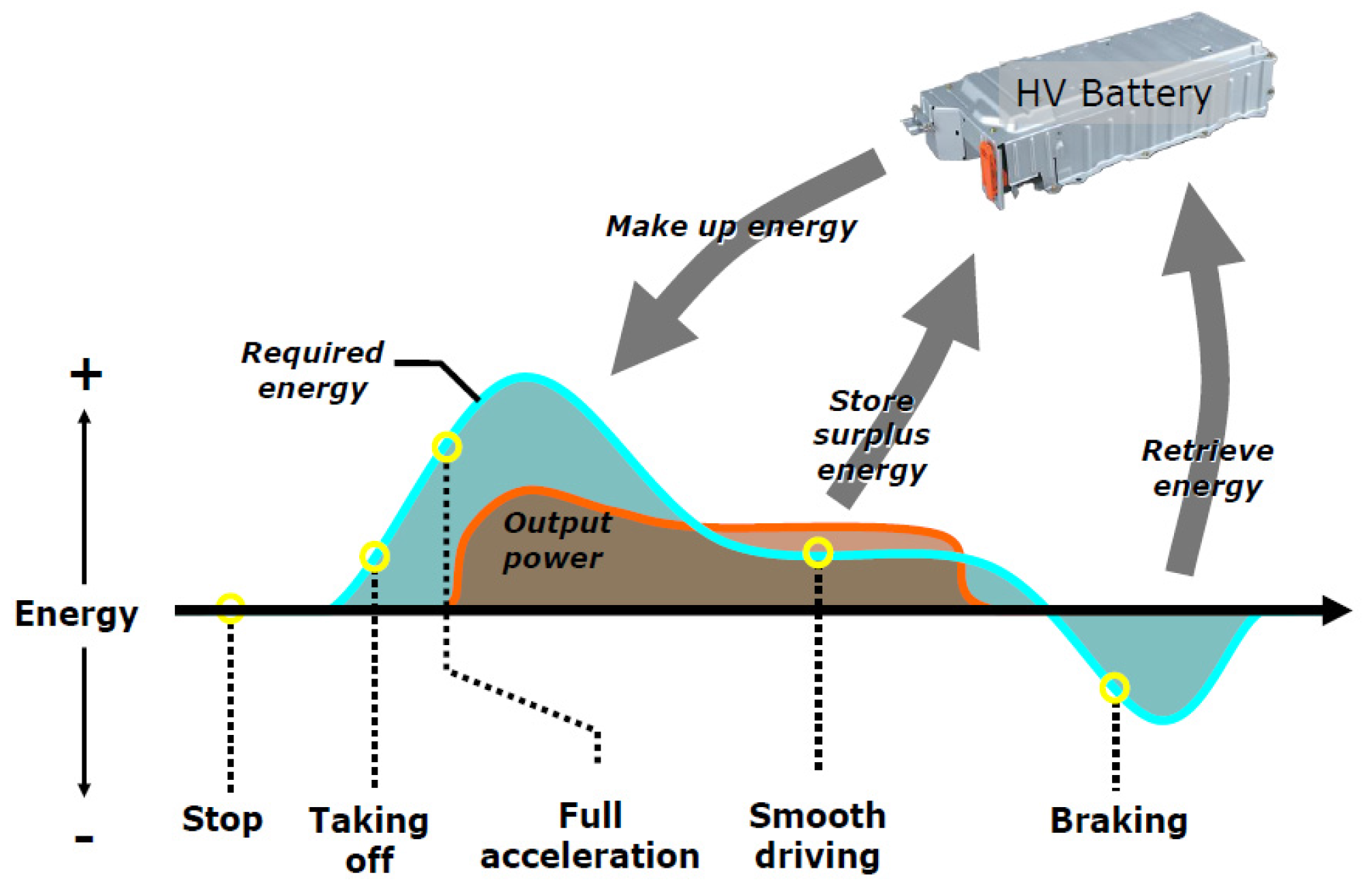


| Displacement (cc) | Range Level (Fuel consumption: km/L) | ||||
|---|---|---|---|---|---|
| Level 5 | Level 4 | Level 3 | Level 2 | Level 1 | |
| ≤1200 | ≤16.1 | 16.2–18.1 | 18.2–20.1 | 20.2–22 | ≥22.1 |
| 1200~1800 | ≤12.9 | 13.0–14.6 | 14.7–16.1 | 16.2–17.7 | ≥17.8 |
| 1800~2400 | ≤11.3 | 11.4–12.8 | 12.9–14.1 | 14.2–15.5 | ≥15.6 |
| 2400~3000 | ≤9.9 | 10.0–11.2 | 11.3–12.4 | 12.5–13.6 | ≥13.7 |
| 3000~3600 | ≤9.1 | 9.2–10.3 | 10.4– 11.4 | 11.5–12.5 | ≥12.6 |
| 3600~4200 | ≤8.4 | 8.5–9.5 | 9.6–10.5 | 10.6–11.6 | ≥11.7 |
| 4200~5400 | ≤7.6 | 7.7–8.1 | 8.2–8.9 | 9.0–9.8 | ≥9.9 |
| >5400 | ≤6.9 | 7.0–7.3 | 7.4–8.1 | 8.2–8.8 | ≥8.9 |
6. Conclusions and Recommendation
Acknowledgments
Author Contributions
Conflicts of Interest
References
- Hsiang, S.M.; Burke, M.; Miguel, E. Quantifying the influence of climate on human conflict. Science 2013, 341, 1212–1226. [Google Scholar] [CrossRef] [PubMed]
- Lamb, H.H. Climate, History and the Modern World, 2nd ed.; Routledge: London, UK, 2002. [Google Scholar]
- Hepbasli, A. A key review on exegetic analysis and assessment of renewable energy resources for a sustainable future. Renew. Sustain. Energy Rev. 2008, 12, 593–661. [Google Scholar] [CrossRef]
- Martin, N.J.; Rice, J.L. Developing renewable energy supply in Queensland, Australia: A study of the barriers, targets, policies and actions. Renew. Energy 2012, 44, 119–127. [Google Scholar] [CrossRef]
- Wee, H.M.; Yang, W.H.; Chou, C.W.; Padilan, M.V. Renewable energy supply chains, performance, application barriers and strategies for further development. Renew. Sustain. Energy Rev. 2012, 16, 5451–5465. [Google Scholar] [CrossRef]
- Bañosa, R.; Manzano-Agugliarob, F.; Montoyab, F.G.; Gila, C.; Alcaydeb, A.; Gómezc, J. Optimization methods applied to renewable and sustainable energy: A review. Renew. Sustain. Energy Rev. 2011, 15, 1753–1766. [Google Scholar] [CrossRef]
- Root, T.L.; Price, J.T.; Hall, K.R.; Schneider, S.H.; Rosenzweig, C.; Pounds, J.A. Fingerprints of global warming on wild animals and plants. Nature 2003, 421, 57–60. [Google Scholar] [CrossRef] [PubMed]
- Vitousek, P.M. Beyond global warming: Ecology and global change. Ecology 1994, 75, 1861–1876. [Google Scholar] [CrossRef]
- Cox, P.M.; Betts, R.A.; Jones, C.D.; Spall, S.A.; Totterdell, I.J. Acceleration of global warming due to carbon-cycle feedbacks in a coupled climate model. Nature 2000, 408, 184–187. [Google Scholar] [CrossRef] [PubMed]
- United Nations. Kyoto Protocol to the United Nations Framework Convention on Climate Change. Available online: http://unfccc.int/essential_background/kyoto_protocol/items/1678.php (accessed on 15 March 2015).
- Feroz, E.H.; Raab, R.L.; Ulleberg, G.T.; Alsharif, K. Global warming and environmental production efficiency ranking of the Kyoto Protocol nations. J. Environ. Manag. 2009, 90, 1178–1183. [Google Scholar] [CrossRef] [PubMed]
- Dovìa, V.G.; Friedlerb, F.; Huisinghc, D.; Klemešd, J.J. Cleaner energy for sustainable future. J. Clean. Prod. 2009, 17, 889–895. [Google Scholar] [CrossRef]
- Hansen, J.E.; Houghton, J. Global Warming: The Complete Briefing, 3rd ed.; Cambridge University Press: Cambridge, UK, 1998. [Google Scholar]
- Union of Concerned Scientists (UCS). Climate Hot Map of Global Warming Effects Around the World. Available online: http://www.climatehotmap.org (accessed on 3 March 2015).
- Lallanilla, M. What is the Greenhouse Effect? Available online: http://www.livescience.com/37743-greenhouse-effect.html (accessed on 3 March 2015).
- Panwar, N.L.; Kaushik, S.C.; Kothari, S. Role of renewable energy sources in environmental protection: a review. Renew. Sustain. Energy Rev. 2011, 15, 1513–1524. [Google Scholar] [CrossRef]
- Hodhe, H. A comparison of the contribution of various gases to the greenhouse effect. Science 1990, 248, 1217–1219. [Google Scholar]
- Robertson, G.P.; Paul, E.A.; Harwood, R.R. Greenhouse gases in intensive agriculture: Contributions of individual gases to the radioactive forcing of the atmosphere. Science 2000, 289, 1922–1925. [Google Scholar] [CrossRef] [PubMed]
- Harabi, N. Appropriability of technical innovations: An empirical analysis. Res. Policy 1995, 24, 981–992. [Google Scholar] [CrossRef] [Green Version]
- Gort, M.; Klepper, S. Time paths in the diffusion of product innovations. Econ. J. 1982, 92, 630–653. [Google Scholar] [CrossRef]
- Shah, A.; Lennström, D.; Sturesson, P.; Easterling, W. NVH integration of twin charger direct injected gasoline engine. SAE Int. J. Passeng. Cars Mech. Syst. 2014, 7, 1221–1228. [Google Scholar] [CrossRef]
- Sclar, D. What Are Hybrid Vehicles? Auto Repair for Dummies, 2nd ed.; John Wiley & Sons, Inc.: Hoboken, NJ, USA, 2014. [Google Scholar]
- Wang, X.M.; He, H.W.; Sun, F.C.; Zhang, J.L. Application study on the dynamic programming algorithm for energy management of plug-in hybrid electric vehicles. Energies 2015, 8, 3225–3244. [Google Scholar] [CrossRef]
- Lund, H. Renewable energy strategies for sustainable development. Energies 2007, 32, 912–919. [Google Scholar] [CrossRef]
- Robinson, J.B.; Herbert, D. Integrating climate change and sustainable development. In Proceedings of the IPCC Expert Meeting, Colombo, Sri Lanka, 27–29 April 1999; pp. 143–162.
- Smit, B.; Pilifosova, O. Adaptation to climate change in the context of sustainable development and equity. In Climate Change 2001: Impacts, Adaptation and Vulnerability; McCarthy, J.J., Canziani, O., Leary, N.A., Dokken, D.J., White, K.S., Eds.; Cambridge University Press: Cambridge, UK, 2001; pp. 877–912. [Google Scholar]
- Frasera, E.D.G.; Dougilla, A.J.; Mabeeb, W.E.; Reeda, M.; McAlpinec, P. Bottom up and top down: Analysis of participatory processes for sustainability indicator identification as a pathway to community empowerment and sustainable environmental management. J Environ. Manag. 2006, 78, 114–127. [Google Scholar] [CrossRef] [PubMed]
- Burton, I. Report on reports: our common future: The world commission on environment and development. Environ. Sci. Policy Sustain. Dev. 1987, 29, 25–29. [Google Scholar] [CrossRef]
- Schalteggera, S.; Synnestvedtb, T. The link between ‘green’ and economic success: environmental management as the crucial trigger between environmental and economic performance. J. Environ. Manag. 2002, 65, 339–346. [Google Scholar]
- Butler, M.A.; King, A.A. Phylogenetic comparative analysis: A modeling approach for adaptive evolution. Am. Nat. 2004, 164, 683–695. [Google Scholar] [CrossRef]
- Ragin, C.C. The Comparative Method: Moving Beyond Qualitative and Quantitative Strategies; University of California Press: Berkeley, CA, USA, 1987. [Google Scholar]
- Stojanovic, V.; Oklobdzija, V.G. Comparative analysis of master-slave latches and flip-flops for high-performance and low-power systems. IEEE J. Solid-State Circuits 1999, 34, 536–548. [Google Scholar] [CrossRef]
- Environmental Protection Administration Taiwan (EPA). Green Car Guidance. Available online: http://greencar.epa.gov.tw/greencar.aspx (accessed on 3 May 2015). (In Chinese)
- Ford Lio Ho (FLH). Ford Turbocharged EcoBoost Engine. Available online: http://www.ford.com.tw/techsection#fullscreen-overlay=cid=1249087333469 (accessed on 3 May 2015). (In Chinese)
- Hotai Motor Co., Ltd. Toyota Prius Hybrid Vehicle. Available online: http://www.toyota.com.tw/tech/ultimate_eco_car_parallax/Ultimate_Eco_Car (accessed on 3 May 2015). (In Chinese)
- Yulon Motors (Nissan). Active Fuel Management (AFM). http://www.yulon-motor.com.tw/car/tech_detail.asp?CTID={8A63B62F-1008-4225-98E7-5D048322263A} (accessed on 3 May 2015). (In Chinese)
- China Motor Co., Ltd.(CMC). Mitsubishi Innovative Valve Timing Electronic Control System. Available online: http://www.china-motor.com.tw/innovate/innovate_04_1.html (accessed on 3 May 2015). (In Chinese)
- Honda Taiwan. Honda Variable Cylinder System (VCM). Available online: http://www.honda-taiwan.com.tw/auto/technology_VCM.html (accessed on 3 May 2015). (In Chinese)
- Industrial Technology Research Institute (ITRI). The Estimation Results of Fuel Consumption and CO2 Emission; The Technical Data of Industrial Technology Research Institute: Chutung, Hsinchu, Taiwan, 21 October 2014. (In Chinese) [Google Scholar]
- The Auto Channel. Toyota and Lexus Hybrids Top One Million Sales in the U.S. Available online: http://www.theautochannel.com/news/2009/03/11/453029.html (accessed on 3 May 2015).
- Toyota Motor Corporation (TMC). Worldwide Prius Sales Top 3 Million. Available online: http://newsroom.toyota.eu/print.do;jsessionid=A753569EFEA6BFD862CD0130EA70FFBE?&id=3515 (accessed on 3 May 2015).
- Toyota Motor Corporation (TMC). Worldwide Sales of Toyota Hybrids Top 6 Million Units. Available online: http://corporatenews.pressroom.toyota.com/releases/worldwide+toyota+hybrid+sales+top+6+million.htm (accesses on 3 May 2015).
- Department of Energy (DOE). EPA’s Top 10 Conventionally-Fueled Vehicles for Model Year 2013. Available online: http://energy.gov/eere/vehicles/fact-765-february-4-2013-epas-top-10-conventionally-fueled-vehicles-model-year-2013 (accessed on 3 March 2015).
- Auto Energy Website (AEW). Vehicle Energy Consumption Modelling and Analysis. Available online: https://auto.itri.org.tw/mode.htm (accessed on 3 March 2015). (In Chinese)
© 2015 by the authors; licensee MDPI, Basel, Switzerland. This article is an open access article distributed under the terms and conditions of the Creative Commons Attribution license (http://creativecommons.org/licenses/by/4.0/).
Share and Cite
Chou, C.-W.; Liao, W.-C.; Wu, S.; Wee, H.-M. The Role of Technical Innovation and Sustainability on Energy Consumption: A Case Study on the Taiwanese Automobile Industry. Energies 2015, 8, 6627-6640. https://doi.org/10.3390/en8076627
Chou C-W, Liao W-C, Wu S, Wee H-M. The Role of Technical Innovation and Sustainability on Energy Consumption: A Case Study on the Taiwanese Automobile Industry. Energies. 2015; 8(7):6627-6640. https://doi.org/10.3390/en8076627
Chicago/Turabian StyleChou, Chao-Wu, Wen-Chih Liao, Simon Wu, and Hui-Ming Wee. 2015. "The Role of Technical Innovation and Sustainability on Energy Consumption: A Case Study on the Taiwanese Automobile Industry" Energies 8, no. 7: 6627-6640. https://doi.org/10.3390/en8076627






